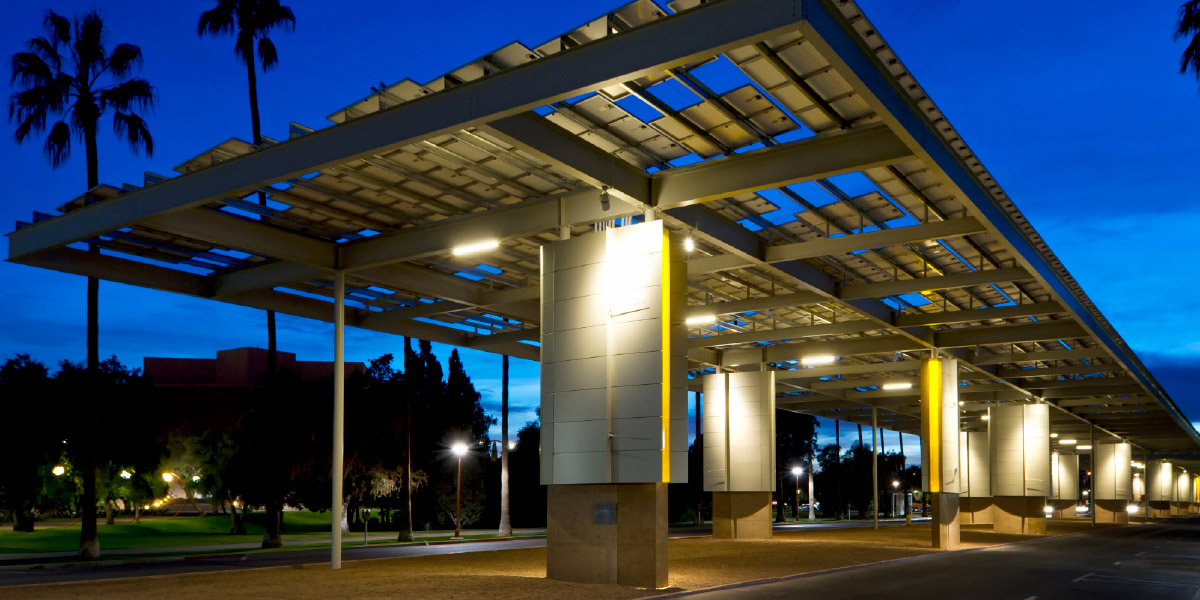Morgan R. Olsen admits that the task of reducing Arizona State University’s emissions impact would be a lot easier if ASU were not one of the fastest-growing research universities in one of the largest metro areas in the country. In the decade since signing the American College & University Presidents’ Climate Commitment, ASU has seen a 33 percent growth in its gross square footage of built space and a 25 percent growth in full-time students on campus. “The good news is that over that same time period, we have dropped carbon emissions by 16 percent,” says Olsen, executive vice president, treasurer, and CFO. “We still have a long way to go, but we have also learned a lot along the way.”
Among those lessons are several strategic approaches that have worked well for ASU.
Bundled benefits. “We always try to think of bundling the benefits of a project,” says Olsen. For instance, most energy efficiency measures help tackle deferred maintenance backlogs, but they also can carry academic and social benefits or provide functional improvements. One case in point is with the solar parasols ASU has erected on campus. “In our climate, it makes sense to use our outdoor space, although we obviously need some protection from direct sunlight. Our solar parasols not only generate power but also provide a shaded outdoor environment for classes or other campus and public events.”
Other people’s money. One reason ASU has been so successful maximizing solar power is because Arizona’s energy regulatory entity has mandated that public utilities provide financial incentives for institutions to implement electrical generation through solar power. The university has been able to tap approximately $250 million of investment from companies willing and able to finance and maintain various solar installations on campus, in exchange for ASU’s long-term purchase of that power. “This is a great example of how we benefit without committing our own capital so that we can reserve our debt capacity for other initiatives critical to our mission,” says Olsen.
Smart design. Most colleges and universities share the daunting challenge of trying to optimize the efficiency of decades-old structures that did not incorporate the most energy-conserving design elements. New construction, on the other hand, offers myriad opportunities to consider efficiency—though it won’t happen by chance, Olsen cautions. “Developing strategies for our built environment has been a journey for us.” But ASU is nothing if not intentional about the process, bringing to the table energy experts, sustainable design practitioners, and facilities maintenance staff. “Our approach looks at the project’s life cycle and energy use, and cost of long-term ownership. Maintaining this focus from the very start helps us avoid mistakes,” says Olsen.
Any new construction on ASU campuses must meet LEED Silver requirements at a minimum, and the university currently has more than 50 LEED-certified structures, including three LEED Platinum buildings, reports Olsen. In addition to making sure the building envelope itself is tight, ASU incorporates design techniques intended to reduce heat transfer, including lots of exterior shading, high-efficiency glass, and a window-to-wall ratio designed to maximize daylighting while minimizing exposure to heat gain. ASU plans to showcase its commitment to climate neutrality and sustainable building systems when it opens its nearly 75,000-square-foot, net-zero energy student pavilion this August. This first foray into net-zero design for ASU will be powered by a photovoltaic parasol, and the roof will be solar-ready for future installations.
RESOURCE LINK For more on ASU’s sustainability efforts and those of a number of other colleges and universities, read “Transfer of Power.”
SUBMITTED BY Karla Hignite, New York City, a contributing editor to Business Officer.




Social Media Skills as Job Strategy